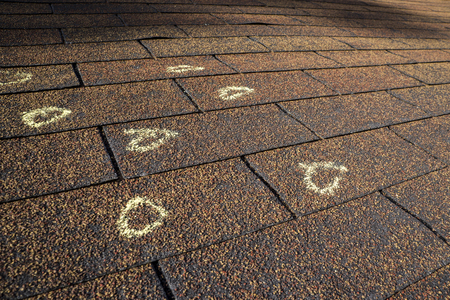When we think about the battering our roofs get over the winter months we usually focus on the risk of damage from torrential rain, howling gales and even the odd lightning strike. Hail damage is usually beneath the radar, partly because most of the hail we get down in the south west is petits pois-sized. But with man-made climate change supposedly increasing the likelihood of freak weather conditions perhaps it’s time we thought about what conditions lead to hail damage and how we can check if our roofs have suffered any hail damage.
Copyright: indyedge / 123RF Stock Photo
Can Hail Really Damage your Roof?
The good news is that hail under an inch in diameter (say 10p size) is unlikely to cause any problems unless the roof is really degraded. Even the softest asphalt shingles can usually withstand hailstones below this size. But what about the rare occasion when the sky starts raining golf balls?
There are many factors that will affect the type and extent of hail damage. These can broadly be split into weather conditions and roof conditions.
Weather conditions include:
- Size of the hailstones
- Their speed
- Their density
- Their direction of travel
- Their shape (hailstones are rarely smooth but some are more jagged than others)
Roof conditions include:
- Roof materials
- Age of roof
- State of repair
- Pitch
- Number of shingle/tile layers (shingles on shingles are more susceptible than shingles on wood)
In terms of roof materials, shingles are the most likely to suffer hail damage but while harder materials such as wood and clay can withstand all but the big tennis ball size hailstones, they tend to crack or shatter completely when they are damaged.
Inspecting a Roof for Hail Damage
One of the main problems with hail damage is becoming aware of it in the first place. Since we can’t see our roofs – or at least the entire roof – from ground level it can sustain a lot of damage without us noticing. Sometimes it is damage to rainwater goods that first alert us to a problem or evidence from a shed roof or external fixture.
We would always recommend that if you want a proper roof inspection for any reason, including hail damage, then it is best to get an experienced roofing firm in.
If you do decide to take a peek yourself, make sure you follow all the usual safety guidelines including wearing soft rubber-soled shoes and a good quality ladder that is high enough to extend above the eaves (never stand on any rungs above the eaves).
Metal most readily show the signs of hail damage so start by looking at your flashing and any metal vents for dents and discolouration. As mentioned above, wood and clay tiles are likely to crack or shatter and you should see dent marks at the point of impact along with some staining – often a brown/orange colour.
Shingles can be trickier to inspect with some signs of hail damage very subtle. Be on the lookout for bald patches where the granules have been displaced on impact. You may then start to notice dents, fractures and tears.
What are the Implications of Hail Damage?
The integrity of your roof is dependant on all of the structure and materials keeping their integrity. While a cracked clay tile looks more serious and should prompt a replacement, displaced granules on shingle tiles can be as bad if not worse. Exposing the shingle beneath to direct sunlight will accelerate its degradation and over time it will begin to crack and blister, losing its ability to keep out water. Algae will also establish a foothold until, before long, the entire roof is compromised leading to water ingress and disinterested insurers who will tell you you should have checked and maintained your roof properly!
To avoid this unwanted scenario, get a roofing firm to give your roof the once over if you suspect hail damage.
